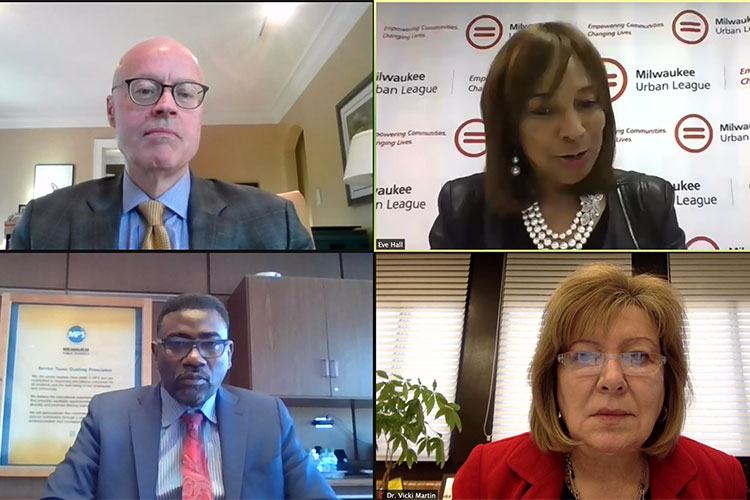Panel discussion lays out M³ trajectory

Milwaukee’s three largest urban institutions of public education share a common goal that has taken on added urgency.
Partnering through the M3 initiative, the University of Wisconsin-Milwaukee, Milwaukee Area Technical College and Milwaukee Public Schools are working to eliminate equity gaps in education. The collaboration already has helped to increase MPS high school graduation rates, helped get more students prepared for college by completing federal financial aid forms, and started a dual enrollment program to help MPS students get a taste of college classes.
The leaders of M3 (pronounced M-Cubed) say more work remains to eliminate inequities that existed long before the economic crisis caused by the COVID-19 pandemic. In fact, a recent study from UWM’s Center for Economic Development found that the Black community in Milwaukee was generally worse off in 2020 compared to 40 or 50 years ago.
“There’s no question that our educational equity gaps are linked to these statistics, though some of the issues will require our community to come together and work beyond just education,” MATC President Vicki Martin said.
Solutions will have to be multifaceted, Martin said, “but access to a family sustaining income is undoubtedly a piece of that puzzle, and education can really help unlock access to that.”
She spoke on Jan. 27 during the latest session of the M3 Education Transformed virtual discussion series. Martin joined UWM Chancellor Mark Mone and MPS Superintendent Keith Posley during the webinar moderated by Eve Hall, president and CEO of the Milwaukee Urban League.
Four years after its official launch, the multifaceted initiative continues to grow. For example, more than 200 MPS students will have gained a collective 2,500 college credits through the M3 College Connections program by the end of the Spring 2021 semester.
The program allows MPS students to attend MATC and UWM while in 12th grade and complete up to 20 college credits before high school graduation. Enrollment has grown steadily since the inaugural 32-member class in 2019.
Other key stats:
- MPS had a four-year high school graduation rate of 69.1% in 2019, up from 58.2% four years earlier
- MPS’ FAFSA completion rate of 74.2% in 2019 was up from 56.7% in 2015
Collaboration across the institutions includes academic staff working together to better align curriculums for critical topics like math, English and science. Coordinated career exploration efforts bring MPS students to MATC and UWM to engage with faculty about potential majors. UWM and MATC staff also work with MPS on outreach efforts to parents about the FAFSA financial aid forms.
The collective work has carried over through the pandemic with classes moving to a virtual environment. For instance, all three institutions continue to respond to emergency needs, such as those students who might need a computer or a steady internet connection.
Posley praised this year’s class College Connections program for persevering through the fall and into another semester of classes that have shifted online because of COVID-19.
“They are preparing and talking about the classes and what it’s going to take to have that rigor” at the college level, Posley said. “They have had opportunity to do some of that work and to know what college life is like.”
Placing renewed emphasis on equity, access and inclusion, MPS last fall created a collaborative, district-wide guidebook that teachers and staff are using to evaluate classroom instruction and culturally responsive teaching of an inclusive curriculum for all learners.
Regionally, UWM and MATC are also founding partners of the Moon Shot for Equity, a comprehensive initiative dedicated to eliminating equity gaps in higher education by 2030.
“There’s power in this relationship. It’s not just a word, ‘M-Cubed,’” Mone said. “It’s true exponential power, where you have three most sizable public institutions of this type in the state that are driving this participation together.”
Hall ended the hourlong event by asking those in the audience to make sure that every high school senior they know has completed the FAFSA form so they can access college financial aid. She encouraged audience members to think about what else they could do to help close equity gaps.
“Thank you again for your time and your interest in an issue that is perhaps more important than any other to the success of our entire community,” Hall said.